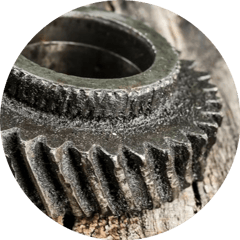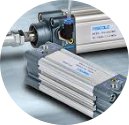

Frictional wear represents the progressive and continuous loss of material from solid surfaces, in reciprocal movement and contact, due to mechanical causes.
Any mechanical device without a uniform lubricating film suffers a loss of material over time, a phenomenon commonly referred to as frictional mechanical wear.
The functionality of the mechanical component is also quickly compromised if the grease or lubricating oil with wich it is equipped does not properly separate the friction surfaces under all working conditions.
Friction is the force that opposes the movement of two bodies in mutual contact. It is divided into static and dynamic, internal and external friction, where:

Mechanical wear is the result of a friction process. There are various ways through which it is accomplished, some of which can be combined and result in joint and destructive actions of:

Loss of material in the form of mechanical wear and tear is inevitable in any friction process. Its occurrence can be minimised through targeted lubrication in tune with operating conditions to prevent premature malfunctioning of the mechanical kinematics involved.
The choice of a suitable grease or lubricating oil passes through the analysis of the tribosystem, being the set of conditions and variables that affect the immediate surroundings of a friction process.
What are the components involved in the analysis of a tribosystem?
Only through a proper analysis of the tribosystem can the most suitable lubricant composition chosen.

Maconsynth GT1/B
Grasso lubrificante a base di idrocarburo sintetico per cilindri pneumatici senza stelo

Pneugrease HTS
Grasso lubrificante a base di polidimetilsilossano per cilindri a basso attrite risparmio energetico

Maconsynth Retrac 400
Grasso lubrificante a base sintetica per cilindri pneumatici con anelli di tenuta in EPDM

Ultragrease ATOX 2
Grasso lubrificante base PAO omologato per contatto accidentale con alimento

Maconsynth GT1/B
Grasso lubrificante a base di idrocarburo sintetico per cilindri pneumatici senza stelo

Pneugrease HTS
Grasso lubrificante a base di polidimetilsilossano per cilindri a basso attrite risparmio energetico

Maconsynth Retrac 400
Grasso lubrificante a base sintetica per cilindri pneumatici con anelli di tenuta in EPDM

Ultragrease ATOX 2
Grasso lubrificante base PAO omologato per contatto accidentale con alimento

HEAD OFFICE:
Macon Research Srl
Via Santa Lucia, 8/D
36056 Tezze sul Brenta (VI)
Tel.+39 0424.57.39.66
Fax.+39 0424.57.39.66
Mail: info@maconresearch.com
ADMINISTRATIVE OFFICE:
Macon Research Srl
Via L. Tolstoj, 43/O
20098 San Giuliano Milanese (MI)
Tel.+39 02.98.24.41.61
Fax.+39 02.98.24.4161
Mail : info@maconresearch.com
The data contained in this catalogue are based on our general experience and knowledge at the time of publication and are intended to provide the reader with technical information about any possible uses. This information does not, however, constitute an assurance as regards product characteristics in relation to specific cases. We recommend that you request an interview with our consultants. We would be happy to provide you with samples.